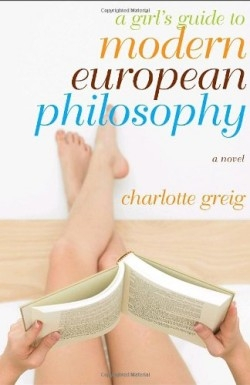A Girl's Guide to Modern European Philosophy
- 2009 INDIES Finalist
- Finalist, General (Adult Fiction)
Ahhhhh, the olden days, back when everyone was, like the narrator of this novel, clueless. Susannah, or Susie-Q, as her lover calls her when he’s drunk, is a twenty-year-old philosophy major at Sussex University in England. She has long flat hair, wears platform shoes, and writes in ‘70s slang. As the novel opens, one of the other students in her Nietzsche tutorial has taken the German philosopher too seriously and gone off the deep end, walking around campus asking annoying questions. Susannah has problems, too. She’s been having lucid dreams in which she looks out the window and sees everything as if in a photographic negative. She has to wake herself up by screaming. That’s all right, she believes, because she can wake up next to her lover, an antiques dealer named Jason, whom she describes as a good-looking, mature man of nearly thirty. But suddenly Jason’s not home, and Susanna finds herself attracted to another student. Rob is young, good-looking, and he really believes in the popular hippie notions of communal living. He insists that he’s in love with her.
The novel comes in three sections. In Philosophy I: Friedrich Nietzsche, Susannah is living the life of a free Nietzschean soul. “I…spent the whole day lying on the floor…reading Nietzsche,” she writes. “I was a free spirit, and like the free spirits of the past, I had a secret destiny, a task to do. I just wasn’t sure what it was yet.” In Philosophy II: Martin Heidegger, she learns what her task may be. She’s pregnant, but doesn’t know if Jason or Rob is the father. She also discovers that whereas a male philosopher can be a free spirit, a female is attached, held down in life, by sheer virtue of [her] biology. In Philosophy III: Søren Kierkegaard, Susannah starts taking some of the philosophy she’s reading seriously. Her dissertation turns into a pensée regarding what to do about her pregnancy, and she has an extremely realistic dream about climbing a mountain with the Danish existentialist. Can she take a leap of faith? Can philosophy tell her whether to have the baby or an abortion?
This coming-of-age book will teach the reader something about the practical applications of philosophy. For readers who survived the ’70s—and may possibly remember those days—it will also be an entertaining read.
Reviewed by
Barbara Ardinger
Disclosure: This article is not an endorsement, but a review. The publisher of this book provided free copies of the book to have their book reviewed by a professional reviewer. No fee was paid by the publisher for this review. Foreword Reviews only recommends books that we love. Foreword Magazine, Inc. is disclosing this in accordance with the Federal Trade Commission’s 16 CFR, Part 255.

